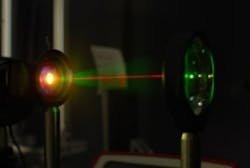New method could make silicon devices responsive to infrared light
Researchers from five institutions have developed a new approach that enables silicon detectors to become responsive to a broad range of infrared lights, potentially opening the door for new infrared imaging systems or solar cell production.
Previously, all methods to develop detectors that are responsive to infrared light have faced limitations, but the new method, which is described in a paper published in Nature Communications, could eliminate these restrictions.
Ordinarily, the MIT press release explains, silicon lets most infrared light pass through and has very little interaction with infrared light. Certain treatments of silicon, however, can mitigate this behavior by creating a waveguide with structural defects or doping it with certain other elements. But this method faces limitations, as it has significant negative effects on silicon’s electrical performance, only works at very low temperatures, or only makes silicon responsive to a narrow band of infrared wavelengths.
In this new method, the system works at room temperature and provides a broad infrared response due to the incorporation of atoms of gold into the surface of the silicon’s crystal structure. The surface of the silicon is then melting for a few nanoseconds, and the atoms recrystallize into a “near-perfect lattice,” and the gold atoms don't have time to escape before getting trapped in the lattice.
The use of gold in the project was a surprise, according to MIT Associate professor of mechanical engineering Tonio Buonassisi.
"Usually gold is incompatible with anything involving silicon, Buonassisi said in the press release. "Even the tiniest particle of it can destroy the usefulness of a silicon microchip — so much so that in many chip-manufacturing facilities, the wearing of gold jewelry is strictly prohibited. "It’s one of the most dangerous impurities in silicon."
However, with the high concentrations achieved by laser doping, gold can have a net positive optoelectronic impact when infrared light shines on the device. Buonassisi says that the efficiency of the system may be too low for use in silicon solar cells, but the method may be application to different materials that would be useful for making solar cells.
The research was funded by the U.S. Army Research Office, the National Science Foundation, the U.S. Department of Energy, and the MIT-KFUPM Center for Clean Water and Energy, a joint project of MIT and the King Fahd University of Petroleum and Mining.
View the press release
Also check out:
Optical sensor tracks zinc in cells for cancer research
(Slideshow) The 12 months of vision: A holiday review of the year in machine vision
MIT develops hand-held scanner for detecting eye disease
Share your vision-related news by contacting James Carroll, Senior Web Editor, Vision Systems Design
To receive news like this in your inbox, click here.
Join our LinkedIn group | Like us on Facebook | Follow us on Twitter | Check us out on Google +.
About the Author

James Carroll
Former VSD Editor James Carroll joined the team 2013. Carroll covered machine vision and imaging from numerous angles, including application stories, industry news, market updates, and new products. In addition to writing and editing articles, Carroll managed the Innovators Awards program and webcasts.
